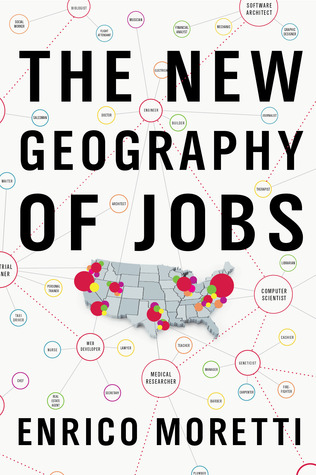The New Geography of Jobs by Enrico Moretti (Book Review)

Enrico Moretti is a celebrated and influential economist whose research has focused on the intersection of labour and urban economics. When I was studying economics, Hsieh and Moretti’s seminal paper on the economic inefficiencies stemming from high housing prices were important in informing my world view. Their paper showed that the most economically successful cities in the United States were also those that had the highest housing prices leading to a spatial “misallocation” between where workers were the most productive and where they could most afford to live. Other Moretti papers have estimated the magnitude of productivity spillovers that innovation clusters lead to for inventors, workers, and firms.
An implication of Hsieh and Moretti’s work is that the long-run cost that housing supply constraints impose is enormous. Based on their methods, US GDP would be 36% higher today if workers could costlessly relocate, and in a more realistic scenario of “housing supply regulation in New York, San Jose, and San Francisco [changing] to that in the median US city”, US GDP would be 14% higher. While these estimates are based on econometric methods whose reliability can be questioned, the fact that such point estimates could be found suggests it is not a trivial problem. I suspect that the costs for a country like Canada are even higher because economic output comes from a handful of cities, most of which have significant housing supply-constraints imposed by government regulation.
I was naturally disappointed after having read The New Geography of Jobs, Moretti’s 2013 book which received acclaim, that the issue of spatial misallocation imposed by government regulation was only briefly discussed. Moretti is a serious scholar, but many segments of the book felt trite and there was a fair share of platitudes and an uncritical acceptance of received wisdom. Consider this statement from the introduction of the book:
Globalization and technological progress have turned many physical goods into cheap commodities but have raised the economic return on human capital and innovation. For the first time in history, the factor that is scarce is not physical capital but creativity. Not surprisingly, innovators capture the largest share of the value of new products. The iPhone is made up of 634 components. The value created in Shenzhen is very low, because assembly can be done anywhere in the world. Even sophisticated electronic parts, like flash memories and retina displays, create limited value, because of strong global competition. The majority of the iPhone’s value comes from the original idea, its unique engineering, and its beautiful industrial design… That matters tremendously, not just for Apple’s profit margin and for our sense of national pride, but because it means good jobs.
There’s a lot to unpack there. First, there are many places in the world which are still desperate for capital and have interest rates which reflect this high rate of return. Second, it is strange to compare the profit margins of a monopoly like Apple, with the mega-city Shenzhen which is literally referred to as the “workshop of the world”. As the COVID-19 pandemic shown, there are actually many things in the world that cannot be manufactured outside of East Asia. Shenzhen is emblematic of the largest expansion of economic prosperity in all of human history, and was one of the founding special economic zones of Deng Xiaoping’s economic reforms. The city literally looks like it comes from the future. In contrast, Apple’s headquarters, San Francisco, relies on infrastructure built around the time of the second world war and barely manages to build 11K housing units per year. Apple directly employs 90K workers in the United States and is the most valuable company in the world as of June 2021 ($2.1 trillion market cap). This is roughly the same number of people employed by General Motors, which has a market capitalization less than 1/20th of Apple. In other words, Apple has created fortunes for its stock holders through branding, but much fewer jobs.

Apple versus this?
The New Geography of Jobs goes to great lengths to explain how the small number of direct jobs created by the likes of Apple are actually much more important to the US economy than their paltry number would suggest. Moretti’s work on job multipliers suggests that for every new job Apple creates, it leads to several jobs in the non-tradeable sector, including those for unskilled workers. Even if this is true, it’s not clear whether such impacts are enough to offset the relatively low numbers of individuals employed in high-tech sector. Additionally, such dependence implies strong income inequality, with a wealthy cadre of productive engineers developing tradeable goods, and a flock of economic dependents servicing their niche consumption tastes. Such bitter class separations may be one of the reasons why Google buses are routinely attacked in the Bay Area.
The most frustrating aspect of the The New Geography of Jobs is that while I am in close political alignment to Moretti, I find his pro-business sentiments too blithe to take seriously. Consider the following:
Currently the American public holds a rather negative view of the social value of financial “innovation,” given the role of derivatives in triggering the Great Recession of 2008-2010. But this is probably an overreaction. While there are important exceptions, by and large financial innovation has contributed to supporting America’s economic growth.
Considering the the long-run economic costs of the 2008 financial crisis are globally in the trillions of dollars, this statement is bizarre. The question isn’t whether some amount of financial services are valuable, but whether the size of the US financial sector is representative of its true social value or a symptom of pathological hypertrophy stemming from implicit bailout guarantees. Moretti is also dismissive of industrial policy geared towards manufacturing, although he supports significant indirect subsidies to “high tech” companies.
Essentially, the “manufacturing activists” propose fighting history. Their arguments–both the sophisticated version and its populist sibling–ignore the simple fact that the forces that have caused the decline of manufacturing are difficult to stop. Like King Canute, the English king who believed he could make the tides recede and then almost drowned, the activists cannot simply command the forces of history.
Through active government policies, countries like Germany and South Korea have maintained a share of the manufacturing workforce at 19% and 17%, respectively, whilst the US is at 10%. Suggesting that subsidies to maintain a higher (relative) share of manufacturing employment are a Canute-like exercise is not only wrong, it seems disinterested in the facts. The question isn’t whether governments can affect the composition of their workforce (they can), the question is whether it is a good use of resources.
Authors usually anticipate the criticisms that will be made against their arguments and try to acknowledge them in advance. While Moretti may have had good answers to such questions, I found them absent in many parts of the book. This New Geography is presented as a structural trend as unalterable as Canute’s tides.[1] For example, Moretti wants to emphasize the important variation in labour market outcomes from geography, not just those of credentials.
The average worker with a high school education living in Boston makes … 44% more than a college graduate in Flint… In other words the disparity between cities is so large that it can dominate the disparity between levels of education.
There are several criticisms to what this statement is trying to imply. First, college graduates are not identical machines, and hence a worker with the same education who stays in Flint Michigan might be very different from one who is willing to move. Second, differences in wages may be completely offset by costs of living. This is why economists compare GDP in purchasing power parity terms. Lastly, these gaps confuse the average with the marginal effect. It may that the existing workers who have located to Boston do indeed earn this premium, but it says nothing about whether the marginal worker should move from Flint to Boston.
In fact, the full return on education for society–sometimes called social return–is larger than its private return. Since college graduates are not compensated for the benefit they bestow on everyone around them there are fewer college graduates than we as a society would ideally like.
Do we need more post-docs as well? The book uncritically uses terms like “education” and “human capital” as though they were as distinguishable as widgets. Attending school is not the same as learning which is not the same thing as human capital. Is the social return the same across disciplines? And what is the variation within disciplines? Once again, making a claim of an average effect tells you nothing about which policies should be pursued, because incentives influence individuals on the margin. The question isn’t whether a straight-A scholastically inclined student should go the college (they will almost certainly earn a premium), the question is whether the marginally interested student, the one with a C+ average who struggles with calculus, should receive additional incentives to go to college when they otherwise would not have attended.
Though the book presents the New Geography’s forces as tide-like, it is almost exclusively focused on the United States.
While its borders and natural landscape are largely immutable, the country’s cities rise and fall as their fortunes change. This has been true and it will be true. Just consider this: although the population of the United Stated has quadrupled since 1900, more than a quarter of US counties have actually lost population in this period, a quarter have grown faster than the average, and the top twenty counties have grown by more than one hundred times.
Tell Poland that a country’s borders are largely immutable! Some paragraphs of the book are so banal, I swear I was listening to a speech by Jim Hacker!
Thus, policies that can increase growth even marginally are vastly more important than any short-term fix to the economy. Our ethos of immediate reward and our almost structural inability to take responsibility for long-term problems is leading us to under-invest in our future. If left unchecked, this tendency could have truly disastrous consequences. The effects will be felt most strongly by our children and by the least fortunate in society.
We live in an age of a new geography...
Most academics are at least a little sceptical of academically-driven research, especially after going through grant applications. Yet Moretti is remarkably bullish on the power of basic research:
The problem is that the difference between private and social return on innovation is much larger than the current subsidies. Bloom and Van Reenan estimate that the social rate of return on R&D is about 38%, almost twice as large as the private return.
Once again, referring to the return of something as varied as research and development would be like referring to the rate of return on business. Which fields? In what era? In what country? Take for example pharmaceutical research, which is characterized by Eroom’s law, in which the cost of developing a drug roughly doubles every nine years. Is this a useful place to put scarce R&D dollars? Or consider the entire sub-field of psychological research into priming which is now considered almost complete noise. Am I to take to these numbers seriously as we obtain more and more evidence into the replication crises for academic research?
Not only is the book America-focused it also seems naively patriotic at times. There is a touch of the Horatio Alger in this paragraph:
In fact, when asked by pollsters, most Americans … answer that they belong to the middle class. I have always thought that this is one of the fundamental cultural differences between the Old and New Worlds, a difference that could account for the stronger entrepreneurial spirit among Americans and the different attitudes toward income inequality and income distribution.
Does it also account for why the US has one of the lowest rates of business formation within the OECD coupled with a declining rate of entrepreneurship? Europe is no longer in the era of Baader-Meinhof or the Italian Communist Party. In many ways the EU today upholds the principles of market competition more strongly than the US. For a Berkeley professor to suggest that America is a classless society is somewhat quaint, and a little hard to believe.
-
Actually, the story is both apocryphal and misunderstood. Canute’s claim to be able to stop the tides was meant as a joke. He used the incident to tell his courtiers: “Let all men know how empty and worthless is the power of kings, for there is none worthy of the name, but He whom heaven, earth, and sea obey by eternal laws.” ↩
